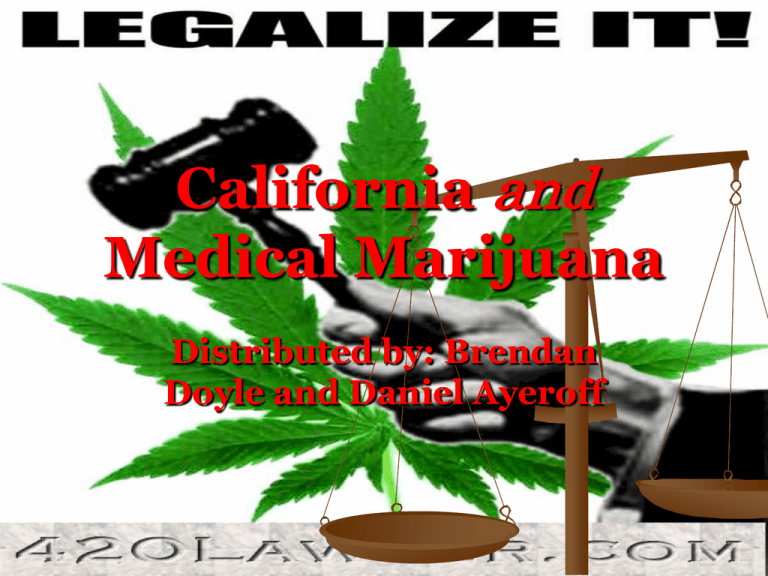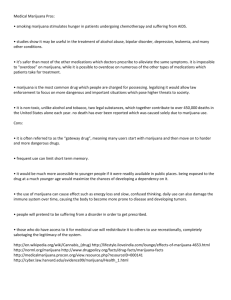California and Medical Marijuana
advertisement

California and Medical Marijuana Distributed by: Brendan Doyle and Daniel Ayeroff Wickard Case Because of the Agricultural Adjustment Act of 1938, farmers could only use a certain amount of land for wheat production This was to stabilize the price of wheat in the national market by controlling the amount of wheat produced Roscoe Filburn was a farmer who produced wheat in excess of the amount permitted The excess wheat was produced for his private consumption on his own farm, so it had nothing to do with commerce at all The Court unanimously reasoned that “the power to regulate the price at which commerce occurs was inherent in the power to regulate commerce” Similarities to Medical Marijuana Case • The Supreme Court in Gonzales v. Raich relied heavily on Filburn in upholding the power of the federal government to prosecute individuals who grow their own medicinal marijuana pursuant to state law • In Raich, the court held that, as with the home grown wheat at issue in Filburn, home grown marijuana is a legitimate subject of federal regulation because it competes with marijuana that moves in interstate commerce Differences to Medical Marijuana Case The law in Wickard exempted small operations, the Wickard case involved commercial operations, and there was "proof" of the impact on interstate commerce. Marijuana is an illegal substance…wheat is not Sandra Day O’Connor’s Opinion O’Connor said that although she would not have voted for the initiative in California, she believed it was an issue to be decided by the state, not the federal government She thought that it was the states’ responsibility to concern themselves with their peoples lives and liberties We disagree with O’Connor, because it is clearly established in the Constitution that it is the government is the ultimate decision maker when it comes to dealing with interstate commerce, which medical marijuana clearly falls into. Although Raich was not personally trafficking marijuana across state lines, there was no reason she couldn’t have. State’s Rights!! Majority Decision The majority of the Supreme Court, consisting of John Paul Stevens, David H. Souter, Ruth Bader Ginsburg, Stephen G. Breyer, Antonin Scalia, and Anthony M. Kennedy, decided that Congress’s constitutional authority to regulate the interstate market in drugs, licit or illicit, extends to small, homegrown quantities of doctorrecommended marijuana consumed under California’s Compassionate Use Act This means that because marijuana can be sold across state lines, it is an interstate transaction that must be regulated by Congress, and thus Federal laws against marijuana use trump state laws allowing it Controlled Substances Act (CSA) The Controlled Substances Act (CSA) is the legal basis by which the manufacture, importation, possession, and distribution of certain drugs are regulated by the federal government of the United States In 2003, the United States Court of Appeals for the Ninth Circuit ruled the CSA illegal as it applied to the use of medical marijuana in the case Raich v. Ashcroft However, the case was appealed to the Supreme Court by the federal government, and in 2005, the Supreme Court ruled in favor of the federal government Clarence Thomas’s Opinion Clarence Thomas stated that if “the majority is to be taken seriously, the federal government may no regulate quilting bees, clothing drives, and potluck suppers throughout the 50 states.” He is saying that the federal government is reaching too far into local affairs. To make this decision legal, they should be consistent and regulate all these other issues. We disagree with Thomas because marijuana is drastically different from all these other issues Can Quilting Bees, Clothing Drives, and Potluck Suppers Affect Interstate Commerce? The Supreme Court could argue that in cases near the borders of states, where people from different states could engage in commerce across a border, these examples would interfere with commerce because of lower prices This is not justified, however, because the impact would be so miniscule The Difference in Marijuana There is a major difference in the examples Clarence Thomas cites and marijuana Marijuana is not only publicly looked downupon, it is a banned substance that can have harmful effects. Quilting bees and the like result in community bonding and a small cash boost, not an illegal and dangerous act. Dealers http://en.wikipedia.org/wiki/Wickard_v._Fil burn http://blogs.salon.com/0002762/stories/20 04/11/23/raichVAshcroftAGuideToTheS.ht ml http://en.wikipedia.org/wiki/Controlled_Su bstances_Act_of_1970#Constitutional_dis putes http://angeljustice.org/


![[H1]Researching Society with MicroCase Online](http://s3.studylib.net/store/data/007737973_2-9d35b9e42208c660471ccaa373bd3b78-300x300.png)



